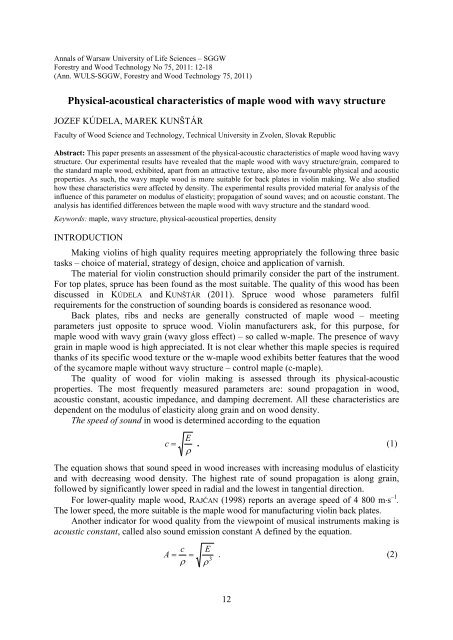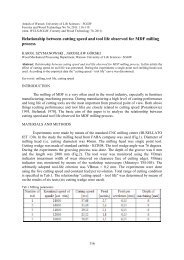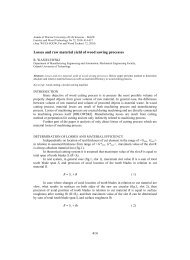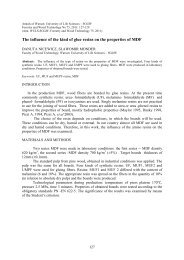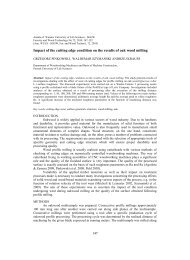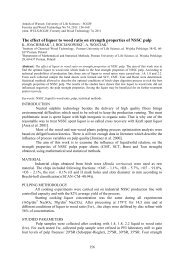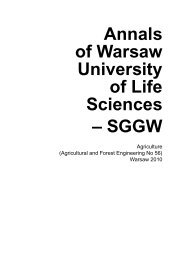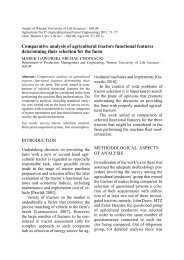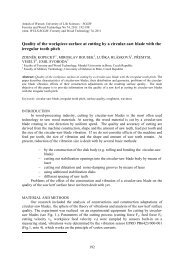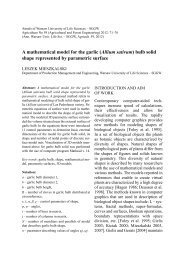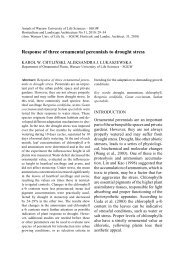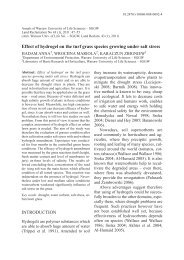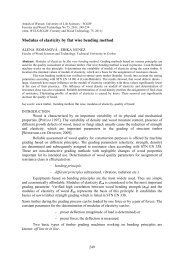Physical-acoustical characteristics of maple wood with wavy structure
Physical-acoustical characteristics of maple wood with wavy structure
Physical-acoustical characteristics of maple wood with wavy structure
Create successful ePaper yourself
Turn your PDF publications into a flip-book with our unique Google optimized e-Paper software.
Annals <strong>of</strong> Warsaw University <strong>of</strong> Life Sciences – SGGW<br />
Forestry and Wood Technology No 75, 2011: 12-18<br />
(Ann. WULS-SGGW, Forestry and Wood Technology 75, 2011)<br />
<strong>Physical</strong>-<strong>acoustical</strong> <strong>characteristics</strong> <strong>of</strong> <strong>maple</strong> <strong>wood</strong> <strong>with</strong> <strong>wavy</strong> <strong>structure</strong><br />
JOZEF KÚDELA, MAREK KUNŠTÁR<br />
Faculty <strong>of</strong> Wood Science and Technology, Technical University in Zvolen, Slovak Republic<br />
Abstract: This paper presents an assessment <strong>of</strong> the physical-acoustic <strong>characteristics</strong> <strong>of</strong> <strong>maple</strong> <strong>wood</strong> having <strong>wavy</strong><br />
<strong>structure</strong>. Our experimental results have revealed that the <strong>maple</strong> <strong>wood</strong> <strong>with</strong> <strong>wavy</strong> <strong>structure</strong>/grain, compared to<br />
the standard <strong>maple</strong> <strong>wood</strong>, exhibited, apart from an attractive texture, also more favourable physical and acoustic<br />
properties. As such, the <strong>wavy</strong> <strong>maple</strong> <strong>wood</strong> is more suitable for back plates in violin making. We also studied<br />
how these <strong>characteristics</strong> were affected by density. The experimental results provided material for analysis <strong>of</strong> the<br />
influence <strong>of</strong> this parameter on modulus <strong>of</strong> elasticity; propagation <strong>of</strong> sound waves; and on acoustic constant. The<br />
analysis has identified differences between the <strong>maple</strong> <strong>wood</strong> <strong>with</strong> <strong>wavy</strong> <strong>structure</strong> and the standard <strong>wood</strong>.<br />
Keywords: <strong>maple</strong>, <strong>wavy</strong> <strong>structure</strong>, physical-<strong>acoustical</strong> properties, density<br />
INTRODUCTION<br />
Making violins <strong>of</strong> high quality requires meeting appropriately the following three basic<br />
tasks – choice <strong>of</strong> material, strategy <strong>of</strong> design, choice and application <strong>of</strong> varnish.<br />
The material for violin construction should primarily consider the part <strong>of</strong> the instrument.<br />
For top plates, spruce has been found as the most suitable. The quality <strong>of</strong> this <strong>wood</strong> has been<br />
discussed in KÚDELA and KUNŠTÁR (2011). Spruce <strong>wood</strong> whose parameters fulfil<br />
requirements for the construction <strong>of</strong> sounding boards is considered as resonance <strong>wood</strong>.<br />
Back plates, ribs and necks are generally constructed <strong>of</strong> <strong>maple</strong> <strong>wood</strong> – meeting<br />
parameters just opposite to spruce <strong>wood</strong>. Violin manufacturers ask, for this purpose, for<br />
<strong>maple</strong> <strong>wood</strong> <strong>with</strong> <strong>wavy</strong> grain (<strong>wavy</strong> gloss effect) – so called w-<strong>maple</strong>. The presence <strong>of</strong> <strong>wavy</strong><br />
grain in <strong>maple</strong> <strong>wood</strong> is high appreciated. It is not clear whether this <strong>maple</strong> species is required<br />
thanks <strong>of</strong> its specific <strong>wood</strong> texture or the w-<strong>maple</strong> <strong>wood</strong> exhibits better features that the <strong>wood</strong><br />
<strong>of</strong> the sycamore <strong>maple</strong> <strong>with</strong>out <strong>wavy</strong> <strong>structure</strong> – control <strong>maple</strong> (c-<strong>maple</strong>).<br />
The quality <strong>of</strong> <strong>wood</strong> for violin making is assessed through its physical-acoustic<br />
properties. The most frequently measured parameters are: sound propagation in <strong>wood</strong>,<br />
acoustic constant, acoustic impedance, and damping decrement. All these <strong>characteristics</strong> are<br />
dependent on the modulus <strong>of</strong> elasticity along grain and on <strong>wood</strong> density.<br />
The speed <strong>of</strong> sound in <strong>wood</strong> is determined according to the equation<br />
E<br />
c . (1)<br />
<br />
The equation shows that sound speed in <strong>wood</strong> increases <strong>with</strong> increasing modulus <strong>of</strong> elasticity<br />
and <strong>with</strong> decreasing <strong>wood</strong> density. The highest rate <strong>of</strong> sound propagation is along grain,<br />
followed by significantly lower speed in radial and the lowest in tangential direction.<br />
For lower-quality <strong>maple</strong> <strong>wood</strong>, RAJAN (1998) reports an average speed <strong>of</strong> 4 800 ms –1 .<br />
The lower speed, the more suitable is the <strong>maple</strong> <strong>wood</strong> for manufacturing violin back plates.<br />
Another indicator for <strong>wood</strong> quality from the viewpoint <strong>of</strong> musical instruments making is<br />
acoustic constant, called also sound emission constant A defined by the equation.<br />
c E<br />
A . (2)<br />
3<br />
<br />
12
High-quality <strong>maple</strong> <strong>wood</strong> requires acoustic constant as low as possible, as violin back<br />
plates primarily serve for the reflection <strong>of</strong> sound waves driven by top plates. RAJAN (1998)<br />
reports average values for acoustic constant 6.71 m 4 kg –1 s –1 and 7.94 m 4 kg –1 s –1 for highquality<br />
<strong>maple</strong> <strong>wood</strong> and lower-quality <strong>maple</strong> <strong>wood</strong>. According to POŽGAJ et al. (1997), the<br />
acoustic constant for common <strong>maple</strong> (Acer campestre) <strong>wood</strong> is 5.8 m 4 kg –1 s –1 .<br />
Acoustic impedance, expressing resistance against plane sound waves is determined by<br />
equation<br />
E<br />
Z c<br />
. (3)<br />
<br />
Logarithmic damping decrement is measured experimentally, based on properties <strong>of</strong> forced<br />
oscillations (RAJAN 1998). For <strong>maple</strong> <strong>wood</strong>, the author reports an average value <strong>of</strong> 0.029.<br />
Equations 1–3 show that the discussed acoustic <strong>characteristics</strong> depend on the modulus <strong>of</strong><br />
elasticity E and the density w <strong>of</strong> <strong>wood</strong>. The values <strong>of</strong> the modulus <strong>of</strong> elasticity are influenced<br />
by a range <strong>of</strong> factors (<strong>wood</strong> moisture content, density, <strong>structure</strong>). FABISIAK and MOLISKI<br />
(2007), MOLISKI and KRAUSS (2008) and several other authors suggest that the modulus <strong>of</strong><br />
<strong>wood</strong> elasticity increases proportionally <strong>with</strong> increasing density. In most cases, this relation<br />
has been reported linear. With increasing moisture content <strong>with</strong>in bound water range, the<br />
modulus <strong>of</strong> elasticity decreases. Significant effect on the modulus <strong>of</strong> elasticity results also<br />
from the method used. In general, it holds that the values <strong>of</strong> dynamic modulus <strong>of</strong> elasticity are<br />
higher than the values <strong>of</strong> static modulus <strong>of</strong> elasticity (ROHANOVÁ 2010). It has also been<br />
revealed that different dynamic methods for determining modulus <strong>of</strong> elasticity resulted in<br />
obtaining different values (ROHANOVÁ 2010). There is evidence that comparisons among<br />
modulus <strong>of</strong> elasticity require using the same method.<br />
All discussed physical-acoustic parameters <strong>of</strong> <strong>wood</strong>, together <strong>with</strong> the modulus <strong>of</strong> elasticity,<br />
are also determined by the <strong>wood</strong> <strong>structure</strong> at all levels – macroscopic, microscopic and submicroscopic.<br />
Quantitative and qualitative presence <strong>of</strong> particular cell types has a significant effect<br />
on <strong>wood</strong> density. That is why the influence <strong>of</strong> <strong>wood</strong> <strong>structure</strong> on its physical-acoustic properties is<br />
usually expressed through its density. The role <strong>of</strong> fibre waviness in <strong>maple</strong> <strong>wood</strong> has not been<br />
found unequivocal. PILA and ŠRÁMEK (1986) declare that the density is not always higher in<br />
presence <strong>of</strong> <strong>wavy</strong> grain. BUCUR (1995) and VINTONIV (1981) also obtained lower density values<br />
for w-<strong>maple</strong>. HOLZ (1974) observed significantly higher density values in w-<strong>maple</strong>. RAJAN<br />
(1998) reports <strong>maple</strong> <strong>wood</strong> density increasing <strong>with</strong> increasing <strong>wood</strong> quality.<br />
For calculations <strong>of</strong> acoustic <strong>characteristics</strong>, we use <strong>wood</strong> density at a given moisture<br />
content w . Wood density and modulus <strong>of</strong> elasticity significantly vary <strong>with</strong> moisture content,<br />
It follows that these two values need to be related to the same moisture content.<br />
The objective <strong>of</strong> this work was to carry out experiments for measuring selected physicalacoustic<br />
properties <strong>of</strong> w-<strong>maple</strong> <strong>wood</strong> and comparing them <strong>with</strong> the properties <strong>of</strong> c-<strong>maple</strong>.<br />
METHODS<br />
The research material was taken from two sample trees from a locality (Lieskovec, C<br />
Slovakia, 800–1000 m a.s.l.) <strong>with</strong> occurrence <strong>of</strong> sycamore <strong>maple</strong> (Acer pseudoplatanus L.)<br />
<strong>with</strong> <strong>wavy</strong> grain. From the bottom parts <strong>of</strong> stems, there were cut two logs, by one from each<br />
stem, having a length <strong>of</strong> 2m (Fig. 1a). The logs were cut to prisms (Fig. 1b) assorted into<br />
zones A, B, C, D (Fig. 1c). The <strong>wood</strong>’s acoustic properties were tested on specimens <strong>with</strong><br />
transverse dimensions <strong>of</strong> 12 12 mm, and a length <strong>of</strong> 800 mm, obtained from the zones A and<br />
C. An analogous set <strong>of</strong> specimens was prepared from <strong>maple</strong> <strong>wood</strong> <strong>with</strong>out <strong>wavy</strong> <strong>structure</strong>. The<br />
specimens for testing the chosen properties were preliminary conditioned at a relative air<br />
humidity = 65 % and a temperature <strong>of</strong> 20 C.<br />
13
a) b) c)<br />
Fig. 1 Cutting layout for preparing test specimens<br />
<strong>Physical</strong>-acoustic <strong>characteristics</strong> were assessed <strong>with</strong> the aid <strong>of</strong> our own measuring<br />
equipment RESONATOR – designed at the Department <strong>of</strong> Physics, Electronics and Applied<br />
Mechanics <strong>of</strong> the Technical University in Zvolen (Fig. 2). The underlying principle is<br />
described in KUBOVSKÝ (2007). The equipment served for measuring resonance frequency f r<br />
(frequency corresponding to the maximum oscillation angle recorded by the recorder) and<br />
frequencies f 1 and f 2 (corresponding to 50% maximum oscillation angles right and left from f r ).<br />
In the following, we used Equations (1 and 2) for obtaining the speed <strong>of</strong> propagation <strong>of</strong><br />
longitudinal wave c, and acoustic constant A. The modulus <strong>of</strong> elasticity E was calculated<br />
according to the equation<br />
2 2<br />
E 4l<br />
f r<br />
<br />
w<br />
, (4)<br />
where l is the specimen’s lengths and f r is resonance frequency corresponding to k = 0.<br />
Wood density corresponding to given moisture content was obtained from the rate <strong>of</strong> the test<br />
specimen’s mass and volume (STN 490108). Moisture content was measured gravimetrically,<br />
following the Standard STN 490103.<br />
<br />
Fig. 2 Computer-controlled equipment RESONATOR <strong>with</strong> DDS: computer, 2 – electronic modulus, 3 – acoustic<br />
modulator 4 – test specimen, 5 – scanner, 6 – digital scale, 7 – digital appliance for measuring specimen dimensions<br />
(KUBOVSKÝ 2007).<br />
RESULTS AND DISCUSSION<br />
The results are summarised in Table 1. All the values relate to a moisture content <strong>of</strong> 11.3 %<br />
– the moisture content <strong>of</strong> the test specimens after conditioning.<br />
Wood density for w-<strong>maple</strong> <strong>wood</strong> ranged from 600 to 685 kgm –3 , meaning significantly<br />
higher values than for c-<strong>maple</strong>. These values meet the criteria set by RAJAN (1998) for highquality<br />
<strong>wood</strong> in violin making. The density values <strong>of</strong> c-<strong>maple</strong> were <strong>with</strong>in 520–630. As such,<br />
they did not reach the values required for violin back plates. Our average density values for<br />
c-<strong>maple</strong> are in accord <strong>with</strong> the results reported by RAJAN (1998) and KURJATKO et al. (2010).<br />
Wood density primarily depends on the morphology and number <strong>of</strong> fibres. The<br />
morphology <strong>of</strong> fibrous cells in <strong>maple</strong> <strong>wood</strong> shows a number <strong>of</strong> atypical features. Maple fibres<br />
are thin-walled. With more than 70 % <strong>of</strong> diameter owing to lumen, <strong>maple</strong> <strong>wood</strong> should be<br />
14
classified as a <strong>wood</strong> <strong>with</strong> low density. Nevertheless, fairly high density <strong>of</strong> <strong>maple</strong> <strong>wood</strong> is the<br />
result <strong>of</strong> a high presence <strong>of</strong> <strong>wood</strong> fibres and a low portion <strong>of</strong> vessels (UNDERLÍK 2010). This<br />
holds especially for w-<strong>maple</strong>.<br />
Table 1 Basic statistical parameters for the studied haracteristics<br />
<strong>of</strong> <strong>maple</strong> <strong>wood</strong><br />
Characteristics Statistical<br />
parameters<br />
w-<strong>maple</strong> c-<strong>maple</strong><br />
Density w<br />
x 641 582<br />
[kgm –3 ]<br />
s 27 34<br />
n 30 30<br />
Modulus <strong>of</strong> elasticity E x 12.10 12.40<br />
[GPa]<br />
s 1.23 1.38<br />
n 30 30<br />
Speed <strong>of</strong> sound x 4337 4613<br />
propagation c<br />
s 170 256<br />
[ms –1 ] n 30 30<br />
Acoustic constant A x 6.77 7.97<br />
[m 4 kg –1 s –1 ]<br />
s 0.31 0.72<br />
n 30 30<br />
The differences in the modulus<br />
<strong>of</strong> elasticity between the two <strong>maple</strong><br />
<strong>wood</strong> types tested were not found<br />
significant. As the modulus <strong>of</strong><br />
elasticity increases <strong>with</strong> increasing<br />
density, we expected that this<br />
parameter should be higher in w-<br />
<strong>maple</strong> tan in o-<strong>maple</strong>. The trend,<br />
however, was revealed just<br />
opposite. Such results support that<br />
not all variance in <strong>wood</strong> <strong>structure</strong><br />
which affects the modulus <strong>of</strong><br />
elasticity, necessarily reflects also in<br />
<strong>wood</strong> density. If the modulus <strong>of</strong><br />
elasticity depended on density<br />
exclusively, the two relations would copy each other. For w-<strong>maple</strong>, a linear dependence <strong>of</strong> the<br />
modulus <strong>of</strong> elasticity on <strong>wood</strong> density has been confirmed; on the other hand, the correlation<br />
between these two parameters was observed relatively low (Fig. 3). Our results, apart from<br />
density, point to several other factors whose effects are at least such strong (50 %) as the<br />
effect <strong>of</strong> density. In case <strong>of</strong> c-<strong>maple</strong>, dependence <strong>of</strong> the modulus <strong>of</strong> elasticity on density has<br />
not been proven. So, well-reasoned is the identification <strong>of</strong> additional factors affecting the<br />
modulus <strong>of</strong> elasticity.<br />
15<br />
w-<strong>maple</strong>, E = -8.338+0.0319*x, r = 0.71<br />
15<br />
c-<strong>maple</strong>, E = 4.388 + 0.0138*x, r = 0.34<br />
Modulus <strong>of</strong> elasticity E [GPa]<br />
14<br />
13<br />
12<br />
11<br />
10<br />
Modulus <strong>of</strong> elasticity E [GPa]<br />
14<br />
13<br />
12<br />
11<br />
10<br />
9<br />
500 550 600 650 700<br />
Density w [kg.m -3 ]<br />
9<br />
500 550 600 650 700<br />
Density w [kg.m -3 ]<br />
Fig. 3 Dependence <strong>of</strong> modulus <strong>of</strong> elasticity on <strong>wood</strong> density<br />
In case <strong>of</strong> w-<strong>maple</strong>, the modulus <strong>of</strong> elasticity is considered mostly affected by <strong>wavy</strong> fibres.<br />
The <strong>wavy</strong> <strong>structure</strong> forces the fibres to turn aside from the longitudinal axis in both directions.<br />
The result is the decrease <strong>of</strong> the modulus <strong>of</strong> elasticity. POŽGAJ et al. 1997) also inform that the<br />
modulus <strong>of</strong> elasticity together <strong>with</strong> acoustic constant is, apart from density, also influenced by<br />
irregular fibre arrangement and fibre twisting. Significant influence is presupposed also for the<br />
submicro-<strong>structure</strong> cell walls. Cell walls consist <strong>of</strong> three layers differing in their chemical<br />
<strong>structure</strong> and the angle <strong>of</strong> their cellulose micro-fibrils. For <strong>wood</strong> properties, S2 layers <strong>of</strong><br />
secondary cell layers are dominant, as they represent 70–80 % <strong>of</strong> cell walls (UNDERLÍK<br />
2010). It follows that, also in this case, it is necessary to study the S2 layers <strong>of</strong> secondary walls<br />
<strong>of</strong> <strong>wood</strong> fibres at sub-microscopic level. ONO and NORIMOTO (1983) report that the internal<br />
<br />
15
friction force and longitudinal modulus <strong>of</strong> elasticity are significantly affected by the angle <strong>of</strong><br />
deviation <strong>of</strong> micro-fibrils in S2 layers <strong>of</strong> secondary walls in <strong>wood</strong> fibres.<br />
The values <strong>of</strong> <strong>wood</strong> density and modulus <strong>of</strong> elasticity were responded by the values <strong>of</strong> the<br />
sound propagation speed and the values <strong>of</strong> acoustic constant. Equations 1 and 2 show that the two<br />
<strong>characteristics</strong> are functions <strong>of</strong> density and the modulus <strong>of</strong> elasticity. In the w-<strong>maple</strong> <strong>wood</strong>, the<br />
speed values were significantly lower. The values increased proportionally <strong>with</strong> increasing <strong>wood</strong><br />
density but showed only a weak correlation (Fig. 4). According to Eq. (1), the speed should<br />
decrease <strong>with</strong> increasing density. The increase in the speed <strong>of</strong> sound wave propagation <strong>with</strong><br />
increasing density was driven by the steeper increase in the modulus <strong>of</strong> elasticity <strong>with</strong> increasing<br />
density. In case <strong>of</strong> c-<strong>maple</strong>, we have not recorded the dependence <strong>of</strong> the modulus <strong>of</strong> elasticity on<br />
density. Consequently, no effect <strong>of</strong> density on the speed <strong>of</strong> sound propagation has been<br />
confirmed. Figure 4 gives more evidence for a decreasing trend. It follows that the dependence <strong>of</strong><br />
the modulus <strong>of</strong> elasticity on density determines also the dependence <strong>of</strong> sound wave propagation<br />
on density.<br />
4800<br />
w-<strong>maple</strong>, c = 2867.7 + 2.2905*x, r = 0.37<br />
5200<br />
c-<strong>maple</strong>, c = 5423.8 -1.3933*x, r = -0.18<br />
4600<br />
5000<br />
Speed c [m.s -1 ]<br />
4400<br />
4200<br />
Speed c [m.s -1 ]<br />
4800<br />
4600<br />
4000<br />
4400<br />
3800<br />
500 550 600 650 700<br />
Density w [kg.m -3 ]<br />
4200<br />
500 550 600 650 700<br />
Density w [kg.m -3 ]<br />
Fig. 4 Dependence <strong>of</strong> sound wave propagation on <strong>wood</strong> density<br />
Also the acoustic constant for w-<strong>maple</strong> was significantly lower than for c-<strong>maple</strong>. The<br />
experimental results have also confirmed that the acoustic constant values decreased<br />
proportionally <strong>with</strong> increasing <strong>wood</strong> density. More remarkable change was observed in case<br />
<strong>of</strong> c-<strong>maple</strong>. As the <strong>wood</strong> density value in Eq. (2) figures in its third power, the influence <strong>of</strong><br />
this parameter has been intensified in detriment <strong>of</strong> other factors. This has been reflected in<br />
closer correlation between the acoustic constant and density (Fig. 5).<br />
<br />
10,0<br />
w-<strong>maple</strong>, A = 11.21- 0.0069*x, r = -0.61<br />
10,0<br />
c-<strong>maple</strong>, A = 17.56 - 0.0165*x, r = -0.78<br />
Acoustic constant A [m 4 .kg -1 .s -1 ]<br />
9,5<br />
9,0<br />
8,5<br />
8,0<br />
7,5<br />
7,0<br />
6,5<br />
Acoustic constant A [m 4 .kg -1 .s -1 ]<br />
9,5<br />
9,0<br />
8,5<br />
8,0<br />
7,5<br />
7,0<br />
6,5<br />
6,0<br />
550 600 650 700<br />
Density w [kg.m -3 ]<br />
6,0<br />
500 550 600 650 700<br />
<br />
Fig. 5 Dependence <strong>of</strong> acoustic constant on <strong>wood</strong> density<br />
Density w [kg.m -3 ]<br />
Comparing the values <strong>of</strong> all the examined physical-acoustic <strong>characteristics</strong> between w-<br />
<strong>maple</strong> <strong>wood</strong> and c-<strong>maple</strong> <strong>wood</strong>, we may declare that w-<strong>maple</strong> <strong>wood</strong> exhibits higher quality. It<br />
meets all requirements for manufacturing back plates <strong>of</strong> violins according to RAJAN (1998).<br />
Another advantage is <strong>wavy</strong> grain inducing the <strong>wavy</strong> gloss effect.<br />
<br />
16
CONCLUSION<br />
The <strong>maple</strong> <strong>wood</strong> <strong>with</strong> <strong>wavy</strong> grain featured, on average, better physical-acoustic<br />
parameters than the <strong>maple</strong> <strong>wood</strong> <strong>with</strong>out <strong>wavy</strong> <strong>structure</strong>. As such, the <strong>wavy</strong> <strong>wood</strong> complies<br />
<strong>with</strong> the criteria set for material for making back plates <strong>of</strong> high-quality violins.<br />
It was demonstrated that the discussed physical-acoustic properties were, apart from<br />
density, influenced by <strong>wood</strong> fibre waviness. Thus, this gives evidence that further research on<br />
the influence <strong>of</strong> this factor on the discussed properties, as well as the study <strong>of</strong> other<br />
differences in <strong>structure</strong> between these two types <strong>of</strong> <strong>maple</strong> <strong>wood</strong> is necessary.<br />
Acknowledgement:<br />
We highly acknowledge the support from the Scientific Grand Agency <strong>of</strong> the Ministry <strong>of</strong><br />
Education SR and the Slovak Academy <strong>of</strong> Sciences (Grant No. 1/0565/10).<br />
REFERENCES<br />
1. BUCUR, V., 1995: Acoustics <strong>of</strong> Wood. Boca Raton – New York – London – Tokyo,<br />
CRC Press, 284 pp.<br />
2. UNDERLÍK, I., 2010: Vplyv štruktúry dreva na jeho kvalitu. In: Parametre kvality<br />
dreva urujúce jeho finálne použitie. (Ed. Kurjatko, S.), Zvolen, Technická univerzita<br />
vo Zvolene, pp. 282–310.<br />
3. FABISIAK, E., MOLISKI, W., 2007: Variation in the micr<strong>of</strong>ibril angle in the<br />
tangential walls <strong>of</strong> the larch <strong>wood</strong> tracheids (Larix decidua Mill.) from plantation<br />
culture. Folia Forestalia Polonica, Seria B, 38(38): 41–53.<br />
4. HOLZ, D., 1974: On some Important Properties <strong>of</strong> Nonmodified Coniferous and<br />
Broad Leaved Woods in View <strong>of</strong> Mechanical and Acoustical Data in Piano<br />
Soundboards. Arch. Akustiky. 9(1):37–57.<br />
5. KUBOVSKÝ, I., 2007: Priama digitálna syntéza – cesta k zdokonaleniu aparatúry na<br />
vyšetrovanie rezonanného dreva. In: : Proceedings <strong>of</strong> the 1 th International<br />
Symposium Material – Acoustics – Place 2007. Zvolen, TU vo Zvolene, pp. 3941.<br />
6. KÚDELA, J., KUNŠTÁR, M., 2011: <strong>Physical</strong>-<strong>acoustical</strong> <strong>characteristics</strong> vs. <strong>wood</strong><br />
density. In: Proceedings <strong>of</strong> the 6 th International Conference Material – Acoustics – Place<br />
2011. Zvolen, TU vo Zvolene, pp. 19. ISBN 978-80-228-2259-6<br />
7. KURJATKO, S. et al., 2010: Parametre kvality dreva urujúce jeho finálne použitie.<br />
Zvolen: Technická univerzita vo Zvolene, 352 pp.<br />
8. MOLISKI, W., KRAUSS, A., 2008: Radial gradient <strong>of</strong> moduluds <strong>of</strong> elasticity <strong>of</strong><br />
<strong>wood</strong> and tracheid cell walls in dominat pine trees (Pinuus sylvestris L). Folia<br />
Forestalia Polonica, Seria B, 39(39): 19–29.<br />
9. ONO T., NORIMOTO M. 1983: Study on Young’s modulus and internal friction <strong>of</strong><br />
<strong>wood</strong> in relation to the evaluation <strong>of</strong> <strong>wood</strong> for musical instruments, Jap. J. Appl. Phys.<br />
22: 611–614.<br />
10. POŽGAJ, A., CHOVANEC, D., KURJATKO, S., BABIAK, M., 1997: Štruktúra<br />
a vlastnosti dreva. Bratislava, Príroda, 488 pp.<br />
11. PILA, V., ŠRÁMEK, F. 1986: Umní houslau. Praha, Panton,<br />
12. RAJAN, E. 1998: Akustika I. Zvolen, TU vo Zvolene, pp. 20–23, 41–43.<br />
13. ROHANOVÁ, A., 2010: Hodnotenie mechanických vlastností smrekového dreva<br />
z pohadu navrhovania drevených konštrukcií. In: Drevo – štruktúra a vlastnosti.<br />
Zvolen, TU vo Zvolene pp. 17–26.<br />
14. STN 49 0103: Drevo. Zisovanie vlhkosti pri fyzikálnych a mechanických skúškach.<br />
1979<br />
15. STN 49 0108: Drevo. Zisovanie hustoty. 1993.<br />
17
16. VINTONIV, I. S., 1981: Nekatorye fizyko-mechanieskie svojstva svilevatoj<br />
drevesniny javora. Les. ž., 24(6):5658.<br />
Streszczenie: Fizyczne i akustyczne wasnoci jaworu falistego. Praca prezentuje ocen<br />
fizycznych i akustycznych wasnoci jaworu falistego. Z porównania wyniko e jawor falisty<br />
oprócz interesujcej struktury posiada lepsze wasnoci fizyczne i akustyczne od zwykego<br />
jawora. Falista struktura drewna nadaje silepiej na pyty dolne instrumentów smyczkowych.<br />
Badano take jak te wasnoci zale od gstoci. Badania zapewniy materia do analiz<br />
wpywu tego parametru na modu sprystoci, propagacj fal i st akustyczn. Wykazano<br />
istotne róznice pomidzy drewnem falistym i zwykym.<br />
Author’s address:<br />
Pr<strong>of</strong>. Ing. Jozef Kúdela, CSc.<br />
Ing. Marek Kunštár<br />
Department <strong>of</strong> Wood Science<br />
Faculty <strong>of</strong> Wood Sciences and Technology<br />
Technical University in Zvolen<br />
T. G. Masaryka 24, 960 53 Zvolen<br />
Slovak Republic<br />
e-mail: kudela@vsld.tuzvo.sk<br />
marek.kunst@gmail.com<br />
18


